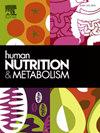间歇性禁食与身体组成:来自伊朗国家肥胖登记处(IRNOR)的见解
IF 1.8
Q3 ENDOCRINOLOGY & METABOLISM
引用次数: 0
摘要
全球肥胖的增加增加了人们对新型饮食方法的兴趣,如5:2间歇性禁食(IF)用于健康管理。本研究旨在评估12周5:2 IF对超重和肥胖个体的传统和新型身体成分指标的影响。方法这项为期12周的纵向队列研究的数据来自伊朗国家肥胖登记处(IRNOR)的电子数据库。根据IRNOR提供的数据,超重或肥胖的成年人根据5:2 IF或每日卡路里限制(CR)计划进行比较。5:2 IF组在禁食日消耗500-600千卡,在非禁食日消耗等热量饮食,而CR组每天减少500-1000千卡的热量摄入。结果共纳入102例患者,平均年龄36.75±12.25岁。在12周内,两组患者的体重、体围和脂肪指标(包括内脏脂肪面积)均显著减少(P <;0.05)。IF组,尽管总热量摄入减少幅度较小,但比CR组多减重1 kg(- 525.33±831.01比- 506.23±763.24,P = 0.08)。与CR组相比,5:2 IF并没有显示出细胞质量、脂肪质量指数、细胞外水/全身总水和相位角随时间的显著降低(P >;0.05)。结论5:2 IF能更好地保持细胞结构和水合平衡,达到临床显著的减肥效果。鉴于其相当的功效,它可能是一个可行的替代方案。需要进一步的研究来证实这些发现。本文章由计算机程序翻译,如有差异,请以英文原文为准。
Intermittent fasting and body Composition: Insights from the Iranian National obesity registry (IRNOR)
Background
The global rise of adiposity has increased interest in novel dietary approaches such as 5:2 intermittent fasting (IF) for health management. This study aimed to assess the impact of a 12-week 5:2 IF on both traditional and novel body composition metrics in individuals with overweight and obesity.
Methods
Data for this12-week longitudinal cohort study was extracted from the electronic database of the Iranian National Obesity Registry (IRNOR). According to data provided by IRNOR, adults with overweight or obesity were compared based on adherence to either 5:2 IF or a daily calorie restriction (CR) program. The 5:2 IF group consumed 500–600 kcal on fasting days and an isocaloric diet on non-fasting days, while the CR group reduced their calorie intake by 500–1000 kcal per day.
Results
A total of 102 participants (mean age 36.75 ± 12.25 years) were included. Over 12 weeks, both groups experienced significant reductions in weight, body circumference, and fat metrics, including visceral fat area (P < 0.05). The IF group, despite a non-significant smaller reduction in total calorie intake, achieved 1 kg greater weight loss than the CR group (−525.33 ± 831.01 vs. −506.23 ± 763.24, P = 0.08). In contrast to the CR group, the 5:2 IF did not show a significant reduction in body cell mass, fat free-mass index, extracellular water-to-total body water, and phase angle over time (P > 0.05).
Conclusions
The 5:2 IF may better preserve cellular structure and hydration balance, achieving clinically significant weight loss. Given its comparable efficacy, it may be a viable alternative. Further studies are required to confirm these findings.
求助全文
通过发布文献求助,成功后即可免费获取论文全文。
去求助
来源期刊

Human Nutrition and Metabolism
Agricultural and Biological Sciences-Food Science
CiteScore
1.50
自引率
0.00%
发文量
30
审稿时长
188 days
 求助内容:
求助内容: 应助结果提醒方式:
应助结果提醒方式:


